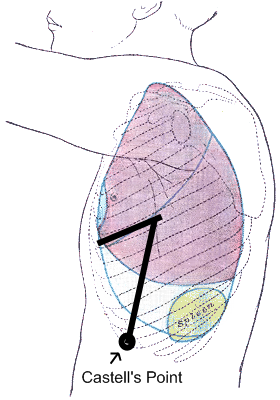Castell’s Percussion Test
Introduction[edit | edit source]
Castell's sign is indicative of splenomegaly and typically part of an abdominal examination. It is an alternative to percussion over Traube's space. Although, splenomegaly is associated with numerous diseases, it remains one of the difficult physical exam findings in the abdomen. Conditions such as infectious mononucleosis, thalassemia, and cirrhotic liver disease may all involve splenomegaly and as a result, the search for a reliable sign associated with this condition has been sought for generations. Castell's sign in conjunction with other clinical information, can be reliably used to indicate the presence or absence of splenomegaly thus increasing the positive predictive value of the test.
Technique[edit | edit source]
NOTE: Percussion may indicate but does NOT confirm splenomegaly.
Castell’s method is demonstrated by percussing the 8th or 9th Left intercostal space (Castell's point) in the anterior axillary line. This space should remain resonant during full inspiration. Dullness on full inspiration indicates possible splenic enlargement (a positive Castell’s sign)[1]
Interpretation[edit | edit source]
- Remains tympanic on inspiration: Splenic Percussion Sign negative: splenomegaly less likely.
- Shift from tympanic to dullness: Splenic Percussion Sign positive: splenomegaly more likely.
References[edit | edit source]
- ↑ Examination of the Spleen. Examination of the Spleen | Stanford Medicine 25 | Stanford Medicine. http://stanfordmedicine25.stanford.edu/the25/spleen.html. Accessed 30 January, 2022.







